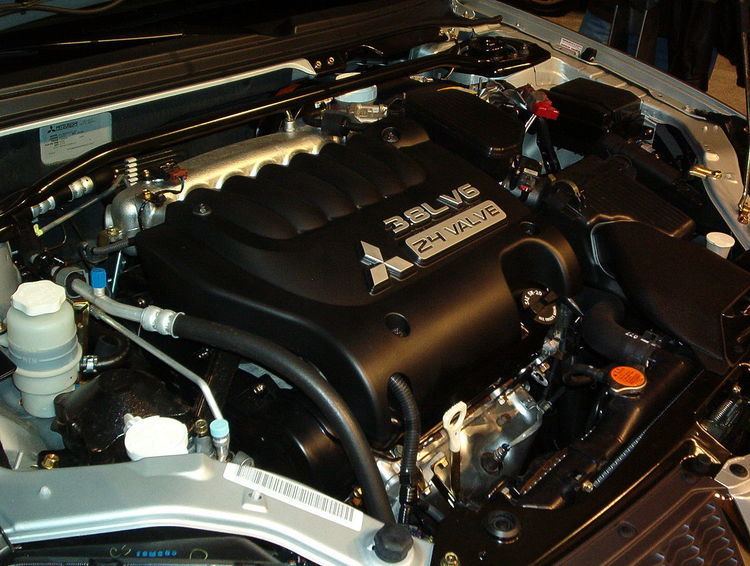Configuration V6 engine | Production 1986- Valvetrain SOHCDOHC | |
 | ||
Displacement 2.0 L2.5 L3.0 L3.5 L3.8 L | ||
The 6G7 or Cyclone V6 engine is a series of V6 piston engines from Mitsubishi Motors. Five displacement variants have been produced from 1986 to present day, with both SOHC and DOHC layouts. While MIVEC variable valve timing has also been implemented in some versions. The 2.5 and 3.0 L versions were also available with gasoline direct injection.
Contents
Bore and Stroke
6G71
The 6G71 model featured SOHC and produced 88 kW (120 PS; 118 hp) at 5,500 rpm and 172 N·m (127 lbf·ft) at 4,500 rpm. It was installed with two valves per cylinder, and used Mitsubishi's ECI-Multi multiple port fuel injection fuel delivery system. The compression ratio was 8.9:1. An earlier version, with single-point fuel injection, only had 105 PS (77 kW) at 5,000 rpm and 16.1 kg·m (158 N·m; 116 lb·ft) at 4,000 rpm.
A supercharger was installed and exclusive to the Debonair. It produces 150 PS (110 kW) at 5,000 rpm and 221 N·m (163 lbf·ft) at 3,000 rpm. The compression ratio for the supercharged model is 8.0:1. The 6G71 engine was also converted to run on LPG, a version which was only available to the Debonair and mainly intended for commercial (taxi) use.
Applications
6G72
The 6G72 was manufactured in three different models which featured SOHC with 12-valves, SOHC with 24-valve, and DOHC with 24-valves.
The latest version was used in the Mitsubishi Eclipse GT and Galant. Output in 2004 was 210 hp (157 kW; 213 PS) at 5500 rpm with 278 N·m (205 lbf·ft) of torque at 4000 rpm. In the older version, used in many Chrysler models since 1987 this V6 was a SOHC 12-valve developing 141 hp (105 kW) at 5000 rpm and 172 lb·ft (233 N·m) of torque at 3600 rpm. The Mitsubishi models were with a 3.0 Litre 6G72 engine SOHC 24-valve developing 195 hp (145 kW) at 5000 rpm and 205 lb·ft (278 N·m) of torque at 4000 rpm.For the MIVEC engine output is 201 kW (273 PS; 270 hp) at 6000 and 304 N·m (224 lbf·ft) at 4500.
The SOHC 12-valve for the second generation of Pajero can provide 109 kW and 235N·m,the SOHC 24-valve can provide 133 kW and 255N·m.
The DOHC 24-Valve was used in the Mitsubishi Debonair, 3000GT and Dodge Stealth producing 222 horsepower (166 kW) and 205 pound force-feet (278 N·m) of torque in naturally aspirated form, and as much as 320 horsepower (240 kW) and 315 pound force-feet (427 N·m) of torque in turbocharged form. Each bank of the V6 had its own independent turbocharger and intercooler. Turbo chargers were Mitsubishi made TD04-9B turbos. They were water cooled to ensure longer service life.
Applications
6G73
The 6G73 is a 24-valve SOHC design with two valves running off a single cam lobe on the exhaust valves using a forked rocker arm and each intake valve actuated with two cam lobes, with a smaller bore than the 3.0 liter version of the same block. Bore and stroke are 83.5 mm × 76 mm (3.29 in × 2.99 in); it is a 60-degree V6 and weighs around 155 kg (342 lb). The engine has low-profile cast aluminum heads which help it to fit into compact engine bays, while pent-roof combustion chambers increase efficiency and make room for four valves per cylinder, arranged in a cross-flow pattern with a "tumble" intake port for both strong breathing and low emissions. Spark plugs are centered in the combustion chambers. The intake valves are 33 mm (1.30 in) in diameter while exhaust valves are 29 mm (1.14 in). It also should be noted that the SOHC 24 valve version of the 6g72 uses these same cylinder heads. A toothed timing belt is used. The output of 6G73 is 161 hp (122 kW; 163 PS) at 5,900 rpm with 221 Nm (163 lb-ft) of torque at 4,350 rpm.
Applications
6G74
The 6G74 is a 24-valve unit available with either SOHC, DOHC, or MIVEC DOHC. Output for the SOHC version varies from 139 kW (189 PS; 186 hp) at 4,750 rpm with 306 N·m (226 lbf·ft) of torque at 3,750 rpm in the Pajero to the highest output of 163 kW (222 PS; 219 hp) at 5,250 rpm with 317 N·m (234 lbf·ft) of torque at 4,500 rpm in the Australian-made Magna Sports, VR-X and Verada GTV/GTVi and 180 kW (240 PS; 240 hp) at 5,500 rpm with 333 N·m (246 lbf·ft) of torque at 4,000 rpm in the Magna Ralliart. For the MIVEC, only available in the Mitsubishi Pajero Evolution, the output is 194 kW (264 PS; 260 hp) at 6,000 and 324 N·m (239 lbf·ft) at 4,500 rpm. It uses MFI fuel injection and uses forged steel connecting rods.
The gasoline direct injection version of the 6G74 was launched in April 1997 as the first GDI V6 engine ever produced. It differed from the basic 6G74 in many ways apart from its unique fuel injection system — it had a crown-curved rather than flat combustion chamber, upright intake ports rather than angled, and a 10.4:1 rather than 10.0:1 compression ratio. Mitsubishi claimed 30 percent better fuel economy, a 30 percent reduction in emissions, and higher power outputs than diesels.
Applications
6G75
The 6G75's Output varies from 172 kW (234 PS; 231 hp) and 339 N·m (250 lbf·ft) to 197 kW (268 PS; 264 hp) and 353 N·m (260 lbf·ft) depending on application. It has forged steel connecting rods.
